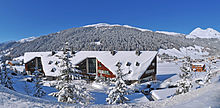Working group for osteosynthesis issues
The AO Foundation , also AO Foundation , is a medical foundation based in Chur , Switzerland. Robert McGuire of the University of Mississippi Medical Center has been president since 2018 . His predecessor was Nikolaus Renner, Head of Traumatology at Aarau Cantonal Hospital . The working group for osteoarthritis questions , from which today's foundation emerged, laid the foundations for a standardization of operative bone fracture treatment from 1958.
founding

The working group for osteosynthesis questions (AO for short) was founded on November 6, 1958 in the Hotel Elite in Biel by 13 Swiss doctors. It is dedicated to research, development and teaching in the field of traumatology ( accident surgery ), in particular the operative bone fracture treatment and the development of suitable metal implants. The initiators of the foundation were Martin Allgöwer from Chur, Maurice E. Müller from Zurich , Robert Schneider (1912–1990) from Großhöchstetten, Walter Bandi from Interlaken and Hans Willenegger (* 1910) from Liestal . Other participants in the founding meeting were René Patry, Fritz Brussatis, August "Urs" Guggenbühl, Ernst Baumann, Walter Schär, Walter Stähli, Willy Hunziker and Walter Ott.
The underlying idea was to achieve early and functional rehabilitation through a firm fixation of the bone fracture. Up until the founding of the AO, fractures were usually closed and sometimes treated for weeks using traction or in a cast. This often resulted in misalignments, restricted mobility and muscle atrophy, so that the subsequent rehabilitation often took months and was associated with long-term inability to work .
Surgical fracture treatment only existed in a few centers without any systematic research. The pioneers included Gerhard Küntscher in Kiel, who developed intramedullary nailing , and Robert Danis in Belgium, whom Maurice E. Müller visited himself to learn his internal fixation methods.
tasks
Between 1960 and 1980, the work of the AO made the modern method of treating bone fractures ( osteosynthesis ) the worldwide standard. Among other things, this resulted in the AO classification for broken bones. The foundation maintains its own research center with several institutes in Davos and Dübendorf . The following institutes belong to the foundation:
- AO Research Institute , in Davos
- AO Education Institute , in Davos
- AO Clinical Investigation , in Dübendorf
- AOTK system , in Davos
literature
- Urs FA Heim: The AO phenomenon. Foundation and first years of the working group for the study of osteosynthesis . Verlag Hans Huber, Bern 2001, ISBN 3-456-83638-4 .
- Eugen H. Kuner: From the end of an agonizing therapy in a stretching bandage. Verlag Kaden-Verlag, Heidelberg 2015, ISBN 978-3-942825-21-4 .
- Thomas Schlich: freedom, equality, loyalty. In: Hubert Steinke, Eberhard Wolff, Ralph Alexander Schmid (eds.): Cuts, knots and networks. 100 years of the Swiss Society for Surgery. Chronos, Zurich 2013, ISBN 978-3-0340-1167-9 , pp. 129–141.
Web links
Individual evidence
- ↑ AO Foundation , Commercial Register of the Canton of Graubünden, accessed on July 19, 2018.
- ^ AO Presidents. Retrieved February 15, 2018 (American English).
- ↑ Thomas Schlich: Schneider, Robert. In: Werner E. Gerabek , Bernhard D. Haage, Gundolf Keil , Wolfgang Wegner (eds.): Enzyklopädie Medizingeschichte. De Gruyter, Berlin / New York 2005, ISBN 3-11-015714-4 , p. 1304.
- ↑ Urs FA Heim: The AO phenomenon. Verlag Hans Huber, Bern 2001, ISBN 3-456-83638-4 , p. 57.
- ^ Davos and Dübendorf